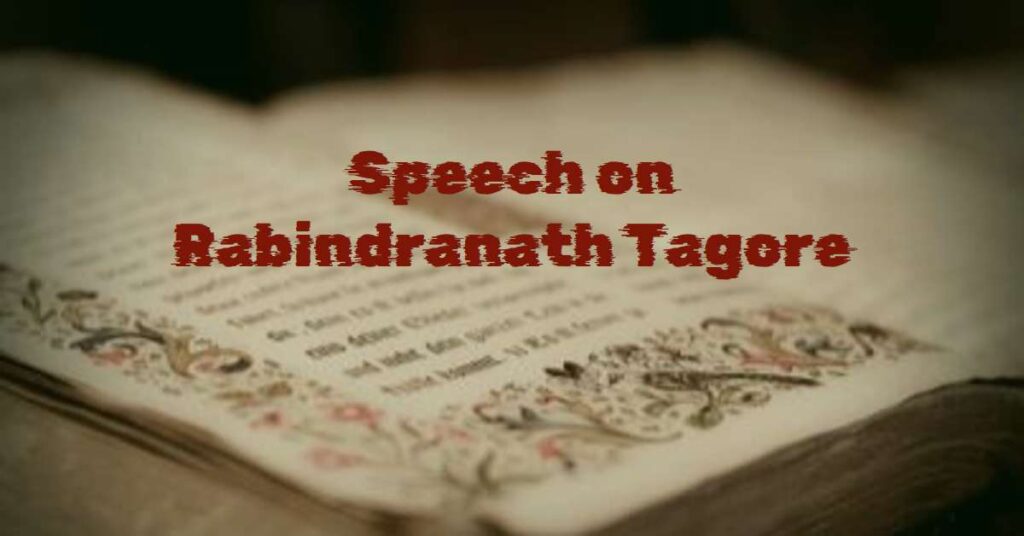
2 Speech on Rabindranath Tagore for Class 5 to 12 Students
Here, we are presenting two different Speech on Rabindranath Tagore for Students and Speakers under word limits of 500 words. This topic is useful for students of classes 1, 2, 3, 4, 5, 6, 7, 8, 9, 10, 11, and 12 in English. These provided speech will help you to present yourself in front of any crowd gathering including your school seminar or any function.
1st Speech on Rabindranath Tagore
Ladies and gentlemen,
Good [morning/afternoon/evening],
It is a pleasure for me to speak to you today about Rabindranath Tagore, a remarkable man whose contributions to philosophy, music, and literature have had a lasting impact on society.
Rabindranath Tagore was a polymath who was born in Calcutta, India, in 1861. He was a musician, poet, philosopher, and artist. Gitanjali, or Song Offerings, is the collection of poems that won him the 1913 Nobel Prize in Literature, making him the first non-European to receive the honor. Tagore’s poetry touches people’s hearts all over the world with its profound and timeless themes of spirituality, nature, and love, transcending cultural boundaries.
Tagore’s influence on Bangladesh’s and India’s national anthems is one of his most important contributions. He wrote the lyrics to both the national anthems of Bangladesh, Amar Sonar Bangla, and India, Jana Gana Mana. These anthems are evidence of Tagore’s skill at expressing, in words and music, the spirit of a country.
In addition to being a titan of literature, Tagore was a visionary philosopher. He thought that education should extend beyond textbooks and traditional classroom settings. In Santiniketan, he established Visva-Bharati University, wherein students were urged to embrace the concordance of the natural world, artistic expression, and human values. His educational philosophies sought to support students’ holistic growth, encourage their creativity, and build a sense of cultural unity.
In addition to his pursuits in literature and education, Tagore was a skilled painter and musician. His works, referred to as Rabindra Sangeet, are still beloved by listeners for their meaningful lyrics and exquisite melodies. Tagore’s profound relationship with nature and his desire to convey the beauty of the world through a variety of mediums were reflected in his artwork.
In a nutshell Rabindranath Tagore’s influence is felt far beyond the boundaries of his home India. His ideas, compositions, and philosophy have been assimilated into global culture. Let us be motivated by Tagore’s dedication to universal values, his appreciation of diversity, and his vision of a world in which education and the arts bring people together as we consider his life and work.
2nd Speech on Rabindranath Tagore
Ladies and gentlemen,
Good [morning/afternoon/evening],
It is a pleasure for me to speak to you today about Rabindranath Tagore, a remarkable man whose contributions to philosophy, music, and literature have had a lasting impact on society.
Rabindranath Tagore was a polymath who was born in Calcutta, India, in 1861. He was a musician, poet, philosopher, and artist. Gitanjali, or Song Offerings, is the collection of poems that won him the 1913 Nobel Prize in Literature, making him the first non-European to receive the honor. Tagore’s poetry touches people’s hearts all over the world with its profound and timeless themes of spirituality, nature, and love, transcending cultural boundaries.
Tagore’s role in shaping the national anthems of both India and Bangladesh was one of his most notable contributions. He wrote the Indian national anthem, Jana Gana Mana, as well as the Bangladeshi national anthem, Amar Sonar Bangla. These anthems bear witness to Tagore’s ability to capture the spirit of a nation through his words and melodies.
Tagore was a literary giant as well as a visionary philosopher. He believed in the value of education beyond textbooks and classrooms. In Santiniketan, he established Visva-Bharati University, where students were encouraged to embrace the harmony of nature, arts, and human values. His educational philosophy aimed to foster individuals’ holistic development, nurture their creativity, and promote a sense of unity among diverse cultures.
Tagore was a talented musician and painter in addition to his literary and educational endeavors. His compositions, known as Rabindra Sangeet, have remained popular due to their melodic beauty and profound lyrics. Tagore’s art reflected his deep connection with nature and his desire to express the world’s beauty through various forms.
Finally, Rabindranath Tagore’s legacy reaches far beyond the boundaries of his native India. His words, music, and philosophy have all become part of the global cultural heritage. Let us be inspired by Tagore’s commitment to universal values, his celebration of diversity, and his vision for a world where the arts and education unite us all as we reflect on his life and work.
Also Read: Children’s Day Speech in English Pdf For Students of Class 5 to 12